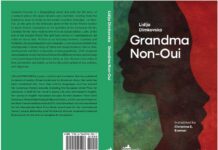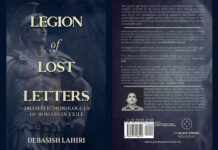Book Review by Rajesh Subramanian
Che cos’è la poesia? What is poetry? This is a question that has never failed to haunt the litterateurs. A three-word question that has elicited / elicits countless answers. One answer that holds water and remains magical to every lover of poetry came from Derrida.
In Derrida’s words, “the risk of the loss in crossing over from one language to another, or already in the transfer into any language at all causes the herrison (hedgehog or porcupine which has the habit of self-defense as soon as it senses strangeness/danger) to roll itself into a ball in the middle of the road and bristle its spines and therefore it may be said of a text that it is spiked itself with difficulties or even traps.”
Poetry, as a narration, is a complex phenomenon in which meaning undergoes multiple rollups till it reaches the reader’s mind, where again it presents different shades at different times. Needless to say, a set of words very likely and more often paint different strokes in the minds of different readers. Derrida mentions that a poem is like a hedgehog crossing a road from one side to the other (from the poet to the reader) and along the path, at the sound of every noise/strangeness it tries to rollup to protect itself and then moves on and on to ultimately reach the other end (the reader).
Oisin Breen, a researcher on narratological complexity, surely would have been conscious of the above delicacy and has crafted his poetry in his inimitable style. A poem, when it attains a final form from the poet’s mind is more often than not a reflection of the countless layers of the past meanings/inner narrations that would have remained overlapping waiting for an exit opportunity from his mind. Oisin chooses his words that complement each other, both temporally and logically, leading to beautiful end products.
Lilies on the Deathbed of Étaín is a collection of six poems, with the lead poem carrying the book’s title; the entire set talks eloquently about the poet’s craftsmanship. The first two are long poems and the last four are comparatively shorter ones.
Lilies on the Deathbed of Étaín, the lead poem, was inspired when the poet attended a close friend’s mother’s funeral. The scenes that he witnessed, apparently, churned in his mind with tens of subconscious layers of narration waiting to be unleashed. Finally, drawing inspiration from the Irish mythological story of Tochmarc Étaíne, the poem flows as words on the paper. Like how Étaíne escaped multiple curses from her lover’s witch wife and took rebirth in different forms, each human being in a single life time takes multiple rebirths to serve in different capacities. Life flows on thus, in its own course. The story repeats itself in unending cycles and the poet captures the nuances brilliantly:
But our death will come in a single reckoning,
a blow that shakes us from navel to heart,
a furious meeting of synapses riffing out sketches
in a stop-start-stop algorithmic play,
All at once,
And not at once.
And I have been dying for such a long time.
Every death, even momentary ones, lead us to the next birth even in the same life time. The poet says:
But in loss there is also the renaissance of stillness: one
heartbeat in which to live, one vision, one mind, and a
coalescence – our footsteps illumined by what we may yet
become.
The second poem, The Love Song of Anna Rua, is more like a musical song, with repetition of melody of sorts. Oisin, about this poem, says: “I repeat verses, but change them subtly, temporally, or semantically, to reflect change. I’m also a big believer in the semantic production of negative space, i.e. that which is unsaid..”
A striking para from the said poem goes like this:
We share the same grave,
Yet, that which we do not share,
It is flowering.
We do not share an epitaph.
And what we do not share is flowering.
We do not share an epitaph,
And mine is dressed only so as to assert:
Independence, mine,
And the certainty of that laughter
I last saw in the mountains,
when I pretended to be a deer and slipped;
when you shouted at me,
while all I thought of
was the whetting of my thirsty beak.
Poetry, as a narrative form of art, is distinct from its other siblings (fiction, essay etc.,) due to its ability to stay longer in a reader’s mind, producing different shades of meaning in an unending way. Words move back and forth, and as deconstructionists/postmodernists would say, the text loses author’s ownership once is it on paper and becomes the reader’s property. Oisin has experimented mixing together his vast acquired literary knowledge and the innovative narratological skills to bring a certain magic to his poems. This is no exaggeration and the reader would vouchsafe this for sure.
*
The poet discusses in detail about this collection of poems in his interview to NewNotePoetry which can be read at : https://www.newnotepoetry.com/post/poet-spotlight-ois%C3%ADn-breen
(About the book : Lilies on the deathbed of Étaín and Other Poems, by Oisín Breen, Downingfield Press, 64pp, £14.99, ISBN 978-0645231816, for online orders: https://www.amazon.co.uk/dp/0645231819)
About the Poet

Oisín Breen, 37, is an Irish poet, journalist, and academic working in the field of narratological complexity. A Best of the Net nominee, Breen is published in 100 journals across 20 countries, including the Tahoma Literary Review, North Dakota Quarterly, About Place, New Critique, Northern Gravy, Reservoir Road, and the Madrigal. This collection follows Breen’s well-received debut Flowers, All Sorts in Blossom, Figs, Berries, and Fruits Forgotten, published by HybridDreich in March 2020. His poem, “Edifices,” was in New Note Poetry’s debut issue, Winter 2021.
About the Reviewer
Rajesh Subramanian is the editor of Modern Literature and is a columnist/literary translator.












